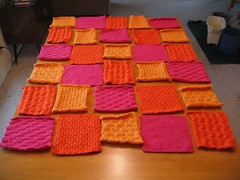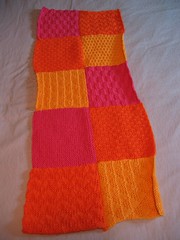I got started last night and spent several hours in frustration. While it hasn't been too difficult using mattress stitch to seam the vertical selvedge edges together, it took me forever to figure out how I wanted to join the horizontal edges, which involves seaming cast-on edges to bound-off edges. I'd never really done this, except for sweater shoulders, where I had the exact same number of stitches on each side -- and both edges were cast-off edges, to boot. I used fake grafting first, following Debbie Stoller's instructions in Stitch 'N Bitch. But I was also looking at Vicki Square's Knitter's Companion. She recommends not pulling the stitches tight -- in other words, the stitches used for grafting are to appear like an extra row of stitches. This would work great if both edges have the same number of stitches and are the same color. That's definitely not the case here.
I tried and rejected several other horizontal seaming techniques.
- Backstitch -- still can't do it.
- Whipstitch -- too sloppy and not invisible
- Crochet seam -- too fiddly and not invisible.
So I ripped out all my feeble attempts and went to bed. This morning, I got up, fed the dog, ate some oatmeal, downed some coffee and restrategized the horizontal seaming. This time I went back to fake grafting, pulled tight, and was completely satisfied. I just have to check the pattern to see the difference in stitch numbers between the two panels I'm joining and work a couple of stitches at a time somewhere along the line -- usually just one or two. I think it's going to work just fine.
Notice how some of my squares still don't appear to be quite the same size? I've decided that this will enhance the patchwork look of the blanket and add to its character. In other words, they're not bugs, they're design features.
If anyone needs me today, I'll be sewing seams...


I love the colors -- it will be beautiful when it's all done!
ReplyDeleteThis is AWESOME! Love the colors, love the textures!
ReplyDeleteCould you block the squares to make them all the same size and then sew them together? I have no idea if this would work, I just thought I'd throw it out there.
You know, I didn't really think of that until I started -- and then I didn't want to stop.
ReplyDeleteThis stuff is 75% acrylic, so I don't know how much it would adjust in blocking. I blocked an acrylic swatch in my earliest knitting days with a steam iron and the piece got all dull and floppy-looking. So I'm kind of scared of that.
I'm still pretty pleased with the way this is turning out, though. I'm just hoping my circular needles are long enough to handle the long edge of this thing!
I agree, Steven - I don't think Plymouth Encore will block because of the acrylic content.
ReplyDeleteI would consult Sally Melville's books The Knit Stitch and The Purl Stitch. She has great instructions (or, as Owen says, "constructions") for seaming in all different circumstances - with photos showing the seam yarn in a constrasting color. LOVE Sally Melville! Those books helped Gretchen in a recent seaming project, too.
Here's another crazy idea: use a 4th color for the seaming and call it a design feature.
Are you using one color for all the seaming, or trying to match whatever block is closest? If you pick one color and don't want to use a 4th, new color, I'd use the one that is in the inside stripe of the (still to be knit) border.
This is the coolest blanket EVER!
The colors are amazing!! I can hardly wait to see how it looks when you've completed it. BTW I found you through Janna.
ReplyDeleteThanks for posting! Janna sure knows a lot of knitters -- as her "post for free sock yarn" contest shows!
ReplyDeleteThis has been a fun project. And with all the days off we've been getting for weather, I've been able to get a lot done! In fact, I'm just about to post pictures of the finished product!